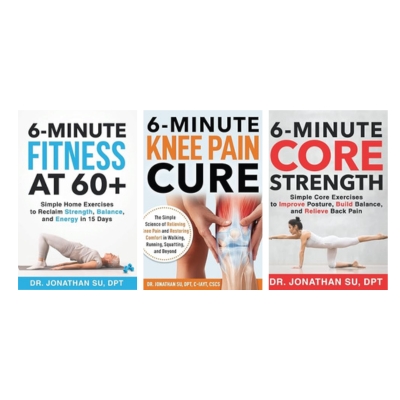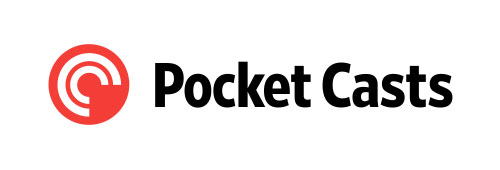 In today’s episode, I had the pleasure of speaking with Dr. Jonathan Su, a renowned physical therapist, yoga therapist, and fitness coach based in the San Francisco Bay Area. Dr. Su shared his invaluable insights on fitness, core strength, and knee pain cure emphasizing the transformative power of strength training and concise, effective workouts.
In today’s episode, I had the pleasure of speaking with Dr. Jonathan Su, a renowned physical therapist, yoga therapist, and fitness coach based in the San Francisco Bay Area. Dr. Su shared his invaluable insights on fitness, core strength, and knee pain cure emphasizing the transformative power of strength training and concise, effective workouts.
Dr. Su’s journey from the U.S. Army to becoming a fitness coach for older adults highlighted a significant shift in his patient demographic. Transitioning from working with young, fit soldiers to primarily serving clients over 60, Dr. Su noticed a gap in knowledge regarding the body’s changing needs with age. This inspired him to author books like “6-Minute Fitness at 60+” and “6-Minute Core Strength” and the latest “6-Minute Knee Pain Cure“.
A key takeaway from Dr. Su’s approach is the concept of minimal, impactful exercise. He advocates for just six minutes of targeted exercise daily, which research shows can significantly enhance muscle mass and overall strength. This approach is particularly beneficial for older adults whose primary fitness goals often revolve around maintaining independence, functionality, and preventing falls.
Dr. Su explained that as we age, we naturally lose muscle mass and balance, which can increase the risk of falls. However, this can be mitigated through strength training. He recommends exercises like chair squats and heel lifts, which can be alternated in high-intensity interval training (HIIT) sessions to build strength efficiently.
Additionally, Dr. Su debunked common misconceptions about core training. Contrary to popular belief, exercises like sit-ups and crunches are not necessary and can even be harmful. Instead, he promotes safer, more effective exercises that maintain a straight spine and build core strength without risking injury.
For those who spend long hours sitting, Dr. Su suggested simple yet effective solutions like performing heel lifts to stimulate circulation and mitigate the negative effects of prolonged sitting. He emphasized that movement, no matter how small, is crucial for maintaining health.
In essence, Dr. Su’s insights offer a practical, manageable approach to fitness for older adults. By focusing on short, effective workouts and understanding the body’s needs, anyone can enhance their vitality and enjoy a more active, fulfilling life well into their later years. Learn more about Dr. Su and his works by visiting his website at sixminutefitness.com.
You may also refer to the transcripts below for the full transciption (not edited) of the interview.
Greg Voisen
Welcome back to Inside Personal Growth. This is Greg Voisen, the host of Inside Personal Growth. And joining me from the San Francisco Bay Area is Dr. Jonathan Su. And he is a physical therapist and a yoga therapist and fitness coach. Good day to you, Jonathan, how you doing?
Dr. Jonathan Su
I'm doing great, Greg, thanks for having me.
Greg Voisen
It's good to have you on the show. Because we have a plethora of things to speak about. And I'm going to show my listeners just he's got three books, but they're all based around the six minutes, right? So 6-Minute Fitness at 60+. And he's got another one called 6-minute Core Strength and he's got another one that interested me because I had a knee injury, the 6-minute Knee Pain Cure. Well, it's a pleasure having you on I'm gonna let our listeners know a little bit about you. As I said, it's physical therapists yoga therapists fitness coach based in the Bay Area. Its clients include entrepreneurs, executives and elite athletes. A former US Army officer. He was officer in charge of injury prevention, rehabilitation and performance optimization for the 25th Infantry Division. Thank you for your service, by the way, appreciate that. He is the co-author of clinical textbook, nutters orthopedic clinical examination and the author of the six minute 50 Sit. Next minute fitness at 60. And the six minute core strength. He serves the fitness panel expert for bottom line, personal and most widely circulated consumer newsletter in the United States. And when he's not busy, said, working with clients, you can find him exploring on the wall restaurants and spending quality time outdoors with his family. Well, pleasure to meet you. Thank you for being on. And thank you. Yeah, thank you for you know, sharing your knowledge and wisdom. I think there there's probably 1000s of listeners that listening to this now that are probably seeing physical therapists. You know, they've had some injury, they've maybe gotten a little older in life, maybe they're not maybe it's just a sports injury for you know, many of people who play soccer on the weekends and they have an injury, and they need it. So what really inspired you to write this six minute fitness? It's 60. We'll focus on that verse. For individuals over 60 years old is that when you were seeing people have more injuries, or less mobility?
Dr. Jonathan Su
So that's a great question. What happened was, my wife and I decided to leave the army about seven years ago. And so all of a sudden, well, what we wanted to do was we wanted to start a family and we didn't want to, you know, be deployed for nine to 12 months at a time we wanted. I wanted to be around for my kids to grow up. So, when I left the army, all of a sudden my patient populations shifted from being young, you know, soldiers who are in shape, super fit to now being mostly 60 plus years. And one of the things I realized was that, you know, no one gave us a user's manual for the human body, as we get older, our bodies change as we get older, and sociate, the way we maintain our bodies, and no one ever told us these things, like, for example, after 60, you lose two to 3% of your muscle mass every year, unless you do strength training. And heck, you know, you can actually still grow muscle, even in your 90s. And I found myself consistently repeating these things to my clients. And I thought, you know, I should just write a book about this, because this is something that people need to know, this should be standard knowledge that we all have.
Greg Voisen
Yeah. And I think, you know, I happen to be listened to a podcast, and I subscribed to it. Dr. Peter Atea, you know, and he gets pretty detailed into things. But he was talking about the older population the other day, just like what you said the same thing, but he had this chart. And he said, for you to sustain a healthy life into your 90s strength training is the most important thing, right? So in other words, lifting weights, even if it's small weights consistent, because the muscle mass after 70. And so maybe I should know this, I'm going to be 70 years old, tomorrow is my birthday. You know, you need to do this. Now I go to the gym three to four times a week, and I lift weights, but not super heavyweights, right, just enough to know that, you know, I can lift the boxes and do the things that I need to do. And I think that's important. So can you explain this concept of six minute fitness? Because most people are like, Oh, good. If I could do it in six minutes, I'll do it. Now. I don't spend six minutes in the gym, I'm in there an hour and a half. But what can people get out of six minutes if they're 60 and older? Yeah,
Dr. Jonathan Su
so, one of the other things I realized was that this population, their goals for fitness is much different than, you know, a 30 or 40 year old, you know, that are trying to, you know, maybe some are, but most of them aren't trying to go to the beach to look good. Most of them are just trying to stay independent and functional and feel good, right. And really to achieve that you don't need a lot of time at the gym, you don't need to exercise a whole lot. And in fact, there's a lot of research showing that six minutes of exercise is enough to change your body.
Greg Voisen
So when you say six minutes, how does the program help improve now one of the things that happens with older people is their gait. And all physical therapists see this because then that's a fall risk. And then for a fall risk, then they could break a hip, or they could break. They could break a leg anything. But the reality is, is that that is the biggest factor for people being hospitalized. So what do you do to help people improve balance, and prevent them being a fall risk, and making sure that their gait stays the same?
Dr. Jonathan Su
Yeah, so there's, there's a lot involved, right, because as we get older, certain things change, for example, we start taking medications that may, you know, affect our blood pressure and you know, may bring on dizziness for some people, which may make them a fall risk and you know, our muscles, we lose muscle mass, our balance starts to you know, wane our nerves, the nerves that come out of our spine that goes to the muscle starts to thin out, so we have less control of our muscles. And a lot of these things we can't change. But the one thing we can change is our muscle mass and our strength. And so for people who are concerned about falls, because of their balance, and you know, gait issues, the foundation of that is to build strength, because that's the one thing you have control of.
Greg Voisen
And so what kind of results if somebody picks up this book, and they read this because you have one on core strength, and then you just have this one, which is about fitness. Now this is the thickest one. So it has more information in it than the other books. But what could they expect to have happen if they follow the advice you have in that book? If someone 60 picks this up and says, Hey, this is fitness over 60 in six minutes? What are some of the things are going to be doing? Like sit ups push ups, jumping jacks? I mean, tell us what what you have in mind.
Dr. Jonathan Su
Yeah, so um, so a lot of the exercises, I noticed that a lot of my older adults perform, they're not really optimal for their age. Personally, I wouldn't recommend situps for older adults, and the reason why is because a lot of that for bending can cause disc herniations lower back injuries. And in fact, a lot of reason Research shows that you actually don't need situps to build core strength anymore. You can have a straight spine and still build abdominal muscles. And so an older adult who hops on to this program, they can expect to improve their strength, their energy, and their balance in about 15 days, if they follow the plan. Now, the reason why that works is because, you know, Japanese researchers for decades now have discovered, you know, the whole the whole Tabata method of fitness, basically high intensity interval training. And high intensity doesn't mean that you're pounding the ground really hard, it doesn't even mean that you're, you know, pushing yourself to the limits, it just means you're, you're training a little harder than you're used to. And the alternate that with, with less intense exercises. So for example, I would have someone do cheer squats for 2030 reps. And then they would do a lower intensity exercise like heel lifts for 2030 reps. And they would alternate back and forth between these two exercises for about six minutes. And that's been shown this type of exercise has been shown to be the most effective and the quickest way to build muscle mass and strength and older adults.
Greg Voisen
So what about it, just giving it somebody's out there today and stretching because you know, one of the biggest injuries that occurs and obviously, as a physical therapist, you see this as somebody doesn't stretch before an exercise. And also, and I know, I bet you 90% of the population doesn't stretch before doing exercise, because that just seems to be Oh, I don't need to stretch, nor do they stretch after the exercise, which I think is recommended as well. And the other thing would be something like yoga, you know, yoga, tai chi, any of these kinds of things where you're giving the body movement, where do you stand as a physical therapist, or having exercises like that, which are low impact, but more stretching exercises, actually be able to obtain the results that you'd want somebody to obtain?
Dr. Jonathan Su
Yeah, those are great exercises, and I love them. Tai Chi yoga, Pilates. The challenge, though, is that many of those routines, they're not pushing the body, they're not pushing the muscles aren't enough through its full range of motion. In order to build the strength most older adults need I would say those are great supplements. But the foundation to fitness is to build muscle mass. And the best way to do that is to take your muscles to a full range of motion, repeatedly with resistance.
Greg Voisen
So when you say resistance, are you saying weight resistance,
Dr. Jonathan Su
you can start with bodyweight resistance. And it depends on what your goal is. If you want to build, you know, I think for most adults, they can, at some point when they can lift their body weight 30 or 40 times repeatedly without any issues, they should put on some resistance, five pounds, 10 pounds something really light, because what you do is you start to build even more muscle and the more muscle you have, of course, to a certain limit, the more buffer you have against, you know falls. And also, if you ever get sick or hospitalized, what happens is your body starts to metabolize your muscle for fuel. And so you start losing a lot of muscle mass, because of you know, being sick or injured or in hospital. And a lot of people come out and you know, with a lot of fatigue and issues, some of them came in and walk after three days in the hospital. So we can build an extra buffer of muscle, then you can prevent all those issues from happening.
Greg Voisen
It's interesting because I have a machine called Total Gym. And it works on its own bodies less leverage. So the way the machine moves up and down, and I'm sure you've probably seen one and pulleys, but it's your own bodyweight. So in essence, what you're doing is by leveraging you're pulling your own body weight, but as the higher you leverage it, the greater it is, the harder it becomes. And it's been a great thing for me, I've actually enjoyed the machine and I stopped using it to go to the gym. But I think I could get just as much of a workout, honestly, on that Total Gym as I'm getting in the gym itself. And this brings me to core strength. You know, when I go to gym, I see people doing a lot of squats. And then I see them doing where they're just they got their arms out and they're building their core strength because this is around core strength where you can see him standing there for or I should say, kind of lying there but with their stomachs up, or what they call that move for about, let's say five minutes, right and What is the core strength? What are some of the misconceptions about core training that you would talk about? And how can you help people? Increase that in the six minutes? Because everything is six minutes, right? I think if I could hold that position for six minutes, I'd be doing pretty good.
Dr. Jonathan Su
Yeah, you know, the one of the biggest misconceptions about core strength is that you have to do sit ups. And what's interesting, if you look at all the exercises in my core strength book, and I think there's over 30 of them, there's not one set up in there. And the reason why is because, you know, the main muscle that's actually working when you're doing situps is your hip flexor muscles, not your abdominals. Yep, that was to get worked, but mostly hip flexor muscles. And additionally, when there's that for bending of the spine, if you do that repeatedly, and I just had a patient recently that I saw, that had, you know, you know, he got a disc herniation as a result, in a lot of pain cat can't do much right now. And, in fact, can't do much for the next few months. His program was essentially doing about 100 Sit ups every day, and then one day boom, sort of caught up with them. So you don't need to do sit ups, or to bend your spine forward in order to build core strength, and crunches. Same thing. In fact, in my opinion, crunches are even worse, because what you're doing with crunches is you're really curving that trunk for it. And every time you do that, if you do that repeatedly, you know, the disk is like a, like a jelly doughnut starts to get squeezed. And I mean, it's okay, if you're, if you're doing that, you know, maybe once or twice a week, but if you're doing that daily, without any rest, there's no time for your discs to heal, and to recover from that compression.
Greg Voisen
So what is this difference between core awareness and core bracing? As you talk about it in your workouts? I don't think any of my listeners have probably heard of that.
Dr. Jonathan Su
Yeah, so, you know, art are the human body's very intelligent. And so what's supposed to happen is that as you go to go pick up something, your your course was automatically tighten, to protect you. But I think what's happened, you know, and I'm not sure exactly why, but I think it's because we sort of live in this modern world where we're sort of, you know, not tune with our bodies anymore, as much as we used to be, because we don't have to use our bodies in the same way. We've sort of forgotten that. So a lot of my patients that I see with low back pain, they just don't have that awareness, or that sort of reaction that we they need to protect the core, which is core bracing, which is basically a stiffening of the core muscles before they go and bend and lift something. And so that's what core bracing is. And what I found was that you can't just tell someone, hey, brace your core, brace your core, because they don't know how to do it's like telling someone to bend a spoon with your mind, you know, and that spoon with your mind, you know, and it's like impossible. So they're trying really hard mentally to do something, but they can't. And that's how it feels to try to brace your core, when you don't have core awareness. And so one of the things I realized was that the first thing we have to develop before developing core bracing is core awareness. allowing the person to understand where their core muscles are, and how do you actually turn them on?
Greg Voisen
Mm hmm. It's very interesting. You know, one of the things I think that older people do, and younger people do way too much on, including myself. And they say the, you know, it's almost like smoking a pack of cigarettes a day. I have a standing desk here. And I have an electric one that goes up and down, right? But the number of times it goes up is far less than the amount that it's actually down. So right now I'm sitting here with you, in a chair, on a cushion that I had I bought this special thing that's supposed to be good for your back. What would you recommend for people? I mean, there's still tons of people in their 60s Plus, that are working, that are sitting at chairs all day long. And I think if there's anything that's probably worse for you, it's just the amount of sitting that we do. What kind of things can they do in between this core strength that can help them you know, be more I always, I always say to myself, Man, I'm not sitting up straight. You know, like, if I was really sitting up straight, I'd be like this during the whole interview, right? But I'm not. I'm like this or I'm like that. So some tips because the reality is, it's a major challenge.
Dr. Jonathan Su
It is it is and you know, what happens when you're sitting for a prolonged period of time, you know, 30 minutes or more is that your metabolism starts to slow down and you're When sugar level increases, your blood cholesterol level increases. There's all these, you know, health effects that happen. And the easiest solution honestly, is to be able to get up and move every 20 or 30 minutes or so. But that's difficult, right? If you're working, and there's deadlines, there's no way you can be going out and walking around for five or 10 minutes every 30 minutes. But what's interesting is that there's there's new research now showing how if you just pump the calf muscles, the deep muscles of your calf, by doing a simple heel lift, while you're sitting, that will actually reverse a lot of the negative effects of sitting.
Greg Voisen
So there's really, that's very interesting. So I just started doing what you're saying on the bar below me on my desk. And you really can feel it on your calves like right away I got to do is four or five of them and you feel it. So is that increasing the circulation in your body? That should be? Because yes, it is. Yeah. Okay. Yeah,
Dr. Jonathan Su
absolutely. So the deep cap calf muscles called the soleus muscle. They are known as the second heart. Every time you walk, that muscle pumps and uh, circulates blood from your legs back to your heart. And we need that because our hearts all the way up here, right. And gravity pulls all that blood and fluid down to our legs, especially if you're you're sitting or standing statically for a prolonged period of time. And so the easiest way to get that fluid and blood back to the heart is to pump that muscle and our bodies designed to do that. I mean, our bodies were designed to move, not to sit for hours and hours. I
Greg Voisen
know I mean, we've the whole Agricultural Age versus this industrial age. And now the digital age is really put people stuck behind desks and computer screens. So you know, I'm, I'm reflecting on what you just said, about moving the calf muscles, right? If you can't get up from the chair, because you're stuck there, you've got to do whatever you've got to do. I think that's, that's wonderful advice. What are some specific core exercise that? Did you kind of include in the book? And how do they benefit kind of the overall health of people? Because these are things that my listeners are wanting to know. So what specific core exercise to have them that you could give our listeners that they could start trying? Yeah,
Dr. Jonathan Su
absolutely. So. So firstly, I'd like to just quickly define the core. And I guess a very general definition of the core, are the deep muscles of our bodies that help support our joints and our spine. So if you think about it, that's really important. Because we have two types of muscles in our body, we have stabilizers and movers. We're more familiar with the movers, these are the big muscles, like our, our thigh muscles in our chest muscles in our muscles, that helps us move our limbs, but deeper to those muscles, they're these tiny muscles that wrap around our joints that actually protect the joints, keep them in line. And so the reason why core strength is so important is because, you know, we need to protect our our joints. And especially, you know, if we look at the number of people with back pain these days as this is the number one chronic pain issue that we have. And I think one of the issues is because we've sort of lost awareness of our core muscles around the trunk. And so in my opinion, two of the most important exercises we can, we can do are just simply doing a core bracing exercise while laying on your back. And then just kind of bringing your legs up into like a tabletop position while keeping the fact flat. Yeah, real simple.
Greg Voisen
And if people want to get more information about this, and I'm going to remind him right now, just go to his website, six minute fitness.com. There, you can learn more about the books. You have access to this. Do you actually have any videos out there showing anybody like on YouTube or anything about that? Or is it just all in the books?
Dr. Jonathan Su
Yeah, so the books will have illustrations, and then there's also links to videos for each of the exercises. That's
Greg Voisen
important for people to know. Now, I know one of the things that happens, Jonathan, and I hear this frequently. amongst people, you know, in my age category is cramps, leg cramps, like calf, in particular. And a lot of times when they're sleeping. Now it doesn't seem to affect me, but it does my wife, but I hear this not only from my wife but from other people. And so what do you tell people to do? That could help prevent that and I know it could be lactic acid induced there could be lots of reasons why Why? And you know more about this than I do. But what would you tell somebody who's regularly getting leg cramps? And some people? It's very debilitating?
Dr. Jonathan Su
Yeah, it can be. And it's very interesting, because when they've done research to determine what is the cause of these type of cramps, Dave, they're inconclusive. They can't pinpoint a specific reason. Right. Some of them will, you know, they looked into like, you know, like, electrolytes and levels, and it just, they can't really pinpoint it. So what I found with my patients with cramps is, you know, sorry, and the other thing is, they also looked at hydration. And that's not consistent either. That's not consistent related.
Greg Voisen
So they can't, they can't tell, because I watched the documentary just the other night. And you may have seen it about Celine Dion, she has this stiff person syndrome. And they actually showed her going through these episodes of what would happen in her whole body would just like stiffen up everything. I mean, like literally, and it was really hard to watch, because she can barely walk now she's having a hard time she's with physical therapists, these people are doing everything they can to try and get her back to where she is. She's lost her voice. Crazy, but there aren't that many people, fortunately, that have stiff person syndrome. Right? Right.
Dr. Jonathan Su
I've actually had one patient recently with stiff person syndrome, and it is debilitating. It's like their whole body, every muscle in their bodies just like in pain. And do they
Greg Voisen
know what causes it? I mean, it doesn't seem like it's there's any diagnosis of it, really. I mean, there's a diagnosis of it, but the treatment of it is they don't know what to do.
Dr. Jonathan Su
Yeah, they don't it's, you know, they know it's a neurological issue. Most likely, you know, when something affects the entire body like that is usually like a central nervous system type issue. But I don't think they've pinpointed exactly what it is and how it happens and how to cure it.
Greg Voisen
But you want to talk about severe leg cramping? Yes, those people have leg cramps that are just, they go on for literally 10 minutes.
Dr. Jonathan Su
Yeah. So, you know, that's, that's a tough one. And I've had patients with that. And the way I think about it is like there can be all these different causes of leg cramps. And if we can make adjustments to one potential cause we can reduce the severity and the duration of the leg cramps. And one thing to try is just some gentle stretching, because what happens is, then now you sort of decrease the neurological tone of the muscle, meaning the rate that the nerves are firing to keep that muscle sort of contracted, you know, the muscles are kind of they have a pulse too. So the nervous system is constantly pinging the muscles to keep them at a certain tone. So even when you're relaxed, there's a tongue. But I think what happens with some people is that that tone is a little too high. And so then it's easier for the muscles to cramp. So I would just do gentle stretching. So instead of the muscles being like this all the time, and all you need is a little bit input to really have them cramp. Now the muscles are like this, and they don't crap this off, and then then I would explode the other issues also like electrolyte levels, hydration levels, and then just start to knock out each of these little things.
Greg Voisen
Well, let's get into this one, because this is you talk about 60 year olds, you don't have to be 60 to get knee pain, or shoulder pain or neck pain, or any of those pains. But this one focuses in on knee pain. And I'm glad you did that. What led you to write it? And why did you post? So focus specifically on knee pain? In particular? And I would think, yes, for 60 year olds, yes. For sports injury people, yes. But for the common person, maybe not dealing with lot of knee pain.
Dr. Jonathan Su
Yeah, so you know, it's interesting knee pain is actually the second most common chronic issue we have in America. And they say, one in four Americans will have knee pain at some point in their life. The reason why I decided to write that book was because I suffered a devastating knee injury when I was 15 years old, and I had a surgeon orthopedic surgeon told me that by the time I was in my 30s, I would need a knee replacement. He told me that I wouldn't be able to, you know, be active in my life. And I'm in my mid 40s now and I have zero knee pain. I still have a very important ligament missing my knees so unstable. And yet I can still run around without any issues. I go running I lift weights. And so, you know, encountering so many people with knee pain as a physical therapist. I saw that they you know a lot of their knee pain could be resolved by I think the challenge is that unless you've been through this type of pain, and you also happen to have training in movement, it's hard to kind of really figure out exactly what you need to do. So I decided to write that book.
Greg Voisen
And so if you can describe the types of exercise and say, here's the most important point in the book that would help us alleviate or even better yet, the exercises we would do, that would be preventative exercises. For us even having the knee pain in the first place. I think part of the issue is we take for granted, just we take so much for granted, but we really take our legs for granted, right? It's like, okay, I get up, I move around, I've been so used to having him walk me around this place for 1000s and 1000s of miles in my lifetime, right. But we don't really do specific exercises for our knees, other than running, walking, right? Maybe going to the gym and lifting some weights that are designed to build the calf muscles. Or I should say, the the what's a large muscle at the top here? I'm just trying to be quadriceps, the quadriceps. Yeah, those those muscles in particular. So your book includes exercises that I would say would be prescriptive, right? Where you could help somebody what are those?
Dr. Jonathan Su
Yeah, so So that's a great question. And you know, you're right, our knees take an impact. And they take the most impact out of any joint in our body, every time we take a step, when we walk it, we put about two to three times our body weight on our knees, every time you run, you put much more than that, like five to 10 times. And so now imagine, right, the average American maybe walks two miles a day, that's about 4000 steps, that's 2000 impacts on one knee every single day. And what happens after years, is that we start to have knee pain is you know, you you'll go to your doctor and they'll Your doctor will say, hey, you need to exercise more Go Go start walking, and two weeks into the walk. Right? People start
Greg Voisen
over how many people is that? osteoarthritis? I don't want to go down the path. But yeah, you know, obviously, you treat a lot of people with osteoarthritis, I'll bet you and they may have it in their hands, they may have their knee, they may have it in his shoulder. So that's inflammatory in nature. So as a PT, I know you're there doing work to move people through it. But aren't you advising them about what they could do to reduce the inflammation?
Dr. Jonathan Su
Well, that's assuming there is inflammation. Because you're right. You know, when there's a postfix of itis, like osteoarthritis, that means there's inflammation but but how do they know there's arthritis? I mean, when you take an x ray of a knee, you can't see arthritis? No, that's true. Right? You can see, like, you know, you know, maybe some development of spurs, you know, thickening of the bone that would indicate, you know, normal wear and tear, but that doesn't really point to what's causing the pain. And what I found was working with so many patients with these really like horrible X rays, right? Like, oh, my gosh, like yes, V or bone on bone arthritis. Once they start doing the types of exercises that, you know, I've been doing weekly on my own body, their their pain starts to reduce. And so, you know, I mean, if you think about it, what's what's what we're really lacking in our culture is this whole idea of having a maintenance program for our bodies. In fact, most of us take better care of our cars than we do our bodies. Right. And so, so we'll say, right, we'll go run, we'll go walk, we'll go lift weights at the gym, but these activities are actually putting mileage on our knees. And what we need to counteract that our tune up exercises, like tune ups for you know, we, we do for our cars, to rebalance our muscles to reduce the stress on our knees. And so the type of exercises that I I've sort of introduced to people are these type of exercises. Let me give you one example of that. So for example, every time you take a step, the key muscles that is contracting, why show
Greg Voisen
people, here's some of the pictures in the book. So this as a guy sitting in a chair, right? And you're showing some exercises here. Roll in a few inches in each direction, move to a different section of the muscle. And in this case, you have a guy that has a roller bar. It's got like a little roller thing behind his the back of his knee. Yeah, yeah, yeah, no This book is extremely well illustrated. I love I just going to show my listeners, they're definitely if you've got knee pain, go out and get this knee pain book because he gives you that. Plus, like you said there are, is there a QR code in here? There's a QR code at the back. So people can see that there's a QR code in the lower left. And you say that that will take them to places you've got that for each of the books, or each one of them. Correct.
Dr. Jonathan Su
And there's QR codes that gives access to videos have all the exercises also,
Greg Voisen
right? There's one here called has this guide helped you. So you have people to leave feedback. But you've got QR codes in here. Plus, you've got exercise, video planners, and more. And I'm going to show this because when we were originally going to do this podcast, we're only going to do this book. So the the scan me, so just scan it with your phone. And then he's got these six minute knee pain, cure exercise planner, okay? And are these downloadable at the same website as well, people like those, I guess they come with book, additional resources. So seriously, folks, if you've got knee pain, go get the six minute knee pain thing. So tell us a couple of them and then tell our listeners how your approach differs from other knee pain treatments, or even preventative treatments? And what kind of results do the list could the listeners expect?
Dr. Jonathan Su
Yeah, sure. So. So what makes this book different is that I suffered knee pain for decades, and I needed to figure out how to solve my own problem. And so that's actually why I became a physical therapist, because everyone else was telling me, hey, there's nothing you can do for your knee, you're gonna have a knee replacement in your 30s. And I was like, No way, I do not want that. And so I essentially spent, you know, the last 20 or so years of my life, trying to figure out knee pain. And, you know, I could say now that in my mid mid 40s, with almost a 30 year injury, that I've successfully resolved my knee pain. And so for most people, what I expect is that if they follow the program, they should notice, honestly, an immediate temporary improvement. That's how I know when we have the right physical therapy exercises for a person, it shouldn't be something that takes weeks to notice a difference. Like we can pinpoint what works, because what works is going to provide an immediate temporary improvement. And over time, as you keep doing the exercises that work, the improvement should be lasts longer and should should be a greater amount of improvement.
Greg Voisen
Are you an advocate of any of these red light laser kind of treatments where the heat of it increases the mitochondria in the area to actually help heal not only the area, but the reduce the inflammation that may have occurred in the pain? Is that something you advocate or? No, I'm just asking off the wall question.
Dr. Jonathan Su
Yeah, I think it can be very helpful. In fact, I've looked into that in the past, and there is some research showing that there are positive, you know, there's benefits of that. What I'm an advocate of is combining those types of treatments with physical therapy, because the body once your body starts to heal, it needs that input to know how to heal. It's kind of like, you know, what happens is if after, you know, you have an injury and you're rehabbing, the reason why we have is so important is because the body doesn't know how to lay down tissues and how much tissue to lay down, unless you have the type of forces that gives that body the input. So I think you need both.
Greg Voisen
So look, there's a lot of orthopedic surgeons that would go in and do orthoscopic surgery, like they're not going to go in and do super invasive, where they're going to replace the knee or, or scrape the knee or whatever. What are you what are your obviously you play a role because you work with patients who've probably coming out after surgery, knee surgery, or a hip surgery. They've had a hip replaced or whatever. And I had Dr. Hanscom from Oakland on here. Really, really fascinating neurosurgeon that did this work for years and years. And, you know, he's a complete turnaround from somebody who was doing back surgeries to advocating zero back surgery and non invasive procedures to do this. I would assume you stand in the same field with Dr. David Hanscom. You might even know him. If you don't know him. I'll be happy to introduce you You to him, but I was fascinated with his whole app and his approach to this. Yeah, yeah,
Dr. Jonathan Su
you're absolutely and you know, because I think it's just in the past, we just didn't have that much research about the body's ability to heal. And now, they're showing that even severely herniated discs, the body can actually heal that this is a process called resorption. And so, you know, sometimes the surgery, you know, does more harm than good, and especially with something like arthroscopic surgery, which is such a simple, you know, surgery. But the challenge is that now you have two traumas to your body, the first trauma from the injury now the second trauma from the surgery, right? And scar tissue and scar tissue. Yes, and yeah, all that adds up over time. Yeah,
Greg Voisen
yeah, no, you're absolutely right. And, you know, I think where you stand is in this field in the middle, obviously, where you understand you, you are treating patients who doctors, orthopedic surgeons have done invasive surgery, or minimally invasive surgery on, because that's your role, that's your job is to help them. And your job is to get them back fully functioning, or as close to fully functioning as possible. And so in kind of wrapping this up between the core strength, and the fitness and the knee fitness, what would you kind of tell our listeners overall, who are 60 Plus, who might be listening to the show, or those who aren't 60 Plus, right? So let's talk about both audiences here that are listening, who are saying, Hey, I would like to do stretches exercises, and be active into my 90s? What kind of things? Would you recommend? You know, like you were mentioning, do some squats behind the chair? You know, some of these things? What would be just some of the basic ones that you would that Jonathan would say, Hey, do these every day or whatever? Or go watch my videos? And you'll see.
Dr. Jonathan Su
Yeah, that's a that's a good question. It's it's difficult to summarize it all, because there's a lot of moving parts, right. But I would say two things. Number one, you got to build muscle strength. That if you're 60 Plus, that's the most important thing. And you could build it, even if you're 90 100 years old, one of my oldest patients is 104 walks without a cane can do push ups can do swell and issues. Yes, anyone can do that. Honestly, anyone can do that, if they work at it. And then the second thing is, then you also have to have in addition to a fitness program, to build strength, a maintenance program. So these are the things that keeps your body aligned, keeps your body in tune. And these are basically muscles that you don't typically think about working like the side of hip muscles. Right.
Greg Voisen
So, so that was a, I'd say, an excellent synopsis. But, and I know that you've got these three books. So for my listeners, you can go get all three and go to his website, you can get one of them at a time, whatever you want to do. But the reality is, in the book are the QR codes opportunity to actually see a video, which I think is extremely important, in this case, also specific instructions in each of these books, like I showed a minute ago as to what to do. And I think that you did an excellent job of summing up all a lot of material in a very short period of time. And I want to thank you, I want to thank you for being on inside personal growth, and taking the time to talk about ni P pain, core strength and fitness after 60. And before 60 Any last parting words you'd like to leave to the listeners?
Dr. Jonathan Su
Thanks for having me, Greg. And what I hope your listeners can walk away with is just a better understanding that physical decline as we age is not something that's inevitable.
Greg Voisen
I love that. Thank you. Thanks so much for being on inside personal growth, and speaking with our listeners, about how not only to prevent these pains, but then once you get them how to actually self treat them through your books. This one is the knee pain book. We'll put them all up on the website. Thanks, Jonathan.
Dr. Jonathan Su
Thanks, Greg.
Sign up to receive email updates
Enter your name and email address below and I'll send you periodic updates about the podcast.











Leave a Reply